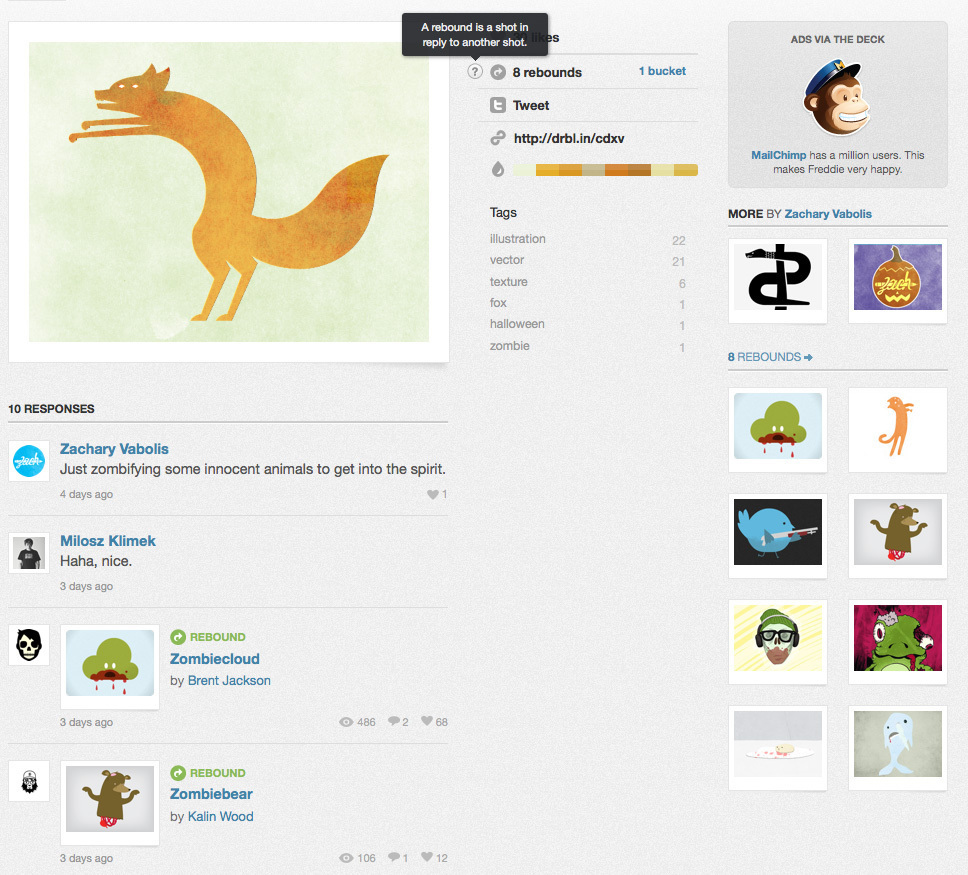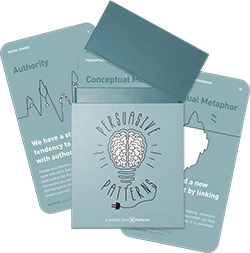Feedback Loops
Design Pattern
Problem summary
We are influenced by information that provides clarity on our actions
Example

▲ At dribbble.com designers upload their own designs in order to get feedback from their peers who can then respond with "rebound" alternate takes on the initial designer's proposal. These can then again be rebounded and so forth. The amount of rebounds a design gets depends on how much exposure it receives, which depends on the amount of likes, comments, tweets, and rebounds. This can lead to the same designs taking frontpage positions for longer periods of time. As a negative feedback form, designs can be browsed by several parameters including color, recency, tags, and popularity.
Usage
- Use when you want to enable users to react immediately on feedback from previous actions.
This card is part of the Persuasive Patterns printed card deck
The Persuasive Patterns Card Deck is a collection of 60 design patterns driven by psychology, presented in a manner easily referenced and used as a brainstorming tool.
Get your deck!Solution
Allow people to play interactively with information so they can adjust their behavior and future actions toward reaching a greater goal. Use numeric data to show progress and translate data into analogous visual information.
Provide measures toward letting users know how what they are doing is affecting the system. This in turn allows users to adjust their behavior and future actions toward reaching a greater goal.
Rationale
Every action creates an equal opposite reaction. When reactions loop back to affect themselves, a feedback loop is created1.
Discussion
There are two types of feedback loops: positive and negative. Where positive feedback amplifies system output, resulting in growth or decline, negative feedback dampens output, stabilizing the system around an equilibrium point. In game design, Fixed rewards are often used as a basis for providing positive and negative feedback loops.
Positive feedback loops
Positive feedback loops are effective for creating change, but generally result in negative consequences if not moderated (or dampened) by negative feedback loops.
Negative feedback loops
Negative feedback loops are effective for resisting change and thus acts as a dampening effect keeping positive feedback loops to go out of control. Negative feedback loops typically act as stabilisers.
Things are connected
Changing one variable in a system will affect other variables in that system and other systems. A designer must not only consider particular elements of a design, but also their relation to the design as a whole and the greater environment1.
Consider positive feedback loops to act as systems for change, and include negative feedback loops to prevent runaway behaviors that lead to system failure. Consider negative feedback loops to stabilize a system, but beware that too much negative feedback can lead to stagnation.
The four distinct stages of a feedback loop
- The evidence stage: A behavior must be measured, captured, and stored. The individual needs to know where he or she stands. You can’t change what you don’t measure.
- The relevance stage: The information must be relayed to the individual, not in the raw-data form in which it was captured but in a context that makes it emotionally resonant. Through information design, social context or some other proxy for meaning, the right incentive will transform rational information into an emotional imperative. The user needs to know if he or she did good or bad.
- Consequence: Even compelling information is useless if we don’t know what to make of it – if it doesn’t tie to into some larger goal or purpose. This is why we need consequence. The information must illuminate one or more paths ahead. People must have a sense of what to do with the information and any opportunities they will have to act on it.
- Action: There must be a clear moment when the individual can recalibrate a behavior, make a choice, and act. Then that action is measured, and the feedback loop can run once more, every action stimulating new behaviors that inch us closer to our goals. The individual has to engage with all of the above and act – thus closing the loop and allowing new action to be measured2.
Feedback systems has been used since antiquity, but the word feedback didn’t exist until 1920 and was not recognized as a universal abstraction until the 1960s with Jay W. Forrester publishing his seminal book on Industrial Mechanics that it gained broader influence as a concept. In the field of psychology feedback loops especially concerned with self-regulation and how processes are purposive and can help self-corrective adjustments.
1 Universal Principles of Design, William Lidwell et. al., Rockport Publishers, 2003
2 Harnessing the power of feedback loops by Thomas Goetz at wired.com
3 Forrester, J. W. (1961). Industrial dynamics. Cambridge, Mass.: M.I.T. Press.
4 Carver & Scheier (1998). On the self-regulation of behavior. New York: Cambridge University Press.
5 Feedback Loops persuasive technique at Learning Loop
User Interface Design Patterns
- Forms
- Explaining the process
- Community driven
- Tabs
- Jumping in hierarchy
- Menus
- Content
- Gestures
- Tables
- Formatting data
- Images
- Search
- Reputation
- Social interactions
- Shopping
- Increasing frequency
- Guidance
- Registration
Persuasive Design Patterns
- Loss Aversion
- Other cognitive biases
- Scarcity
- Gameplay design
- Fundamentals of rewards
- Gameplay rewards


